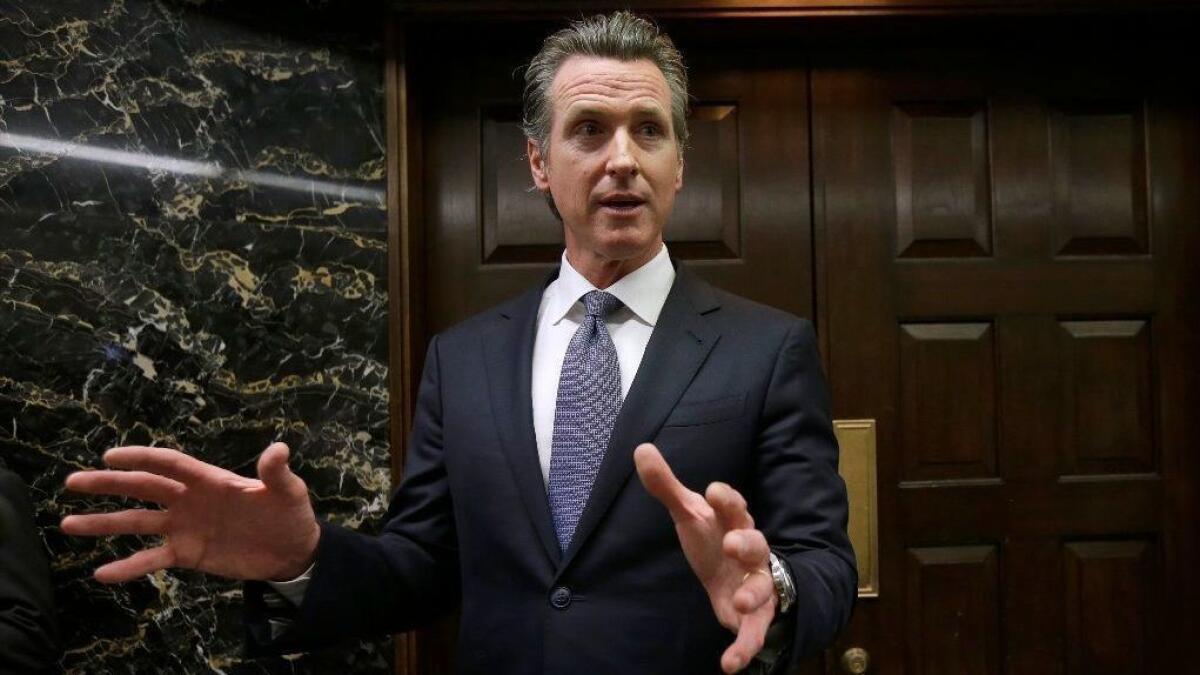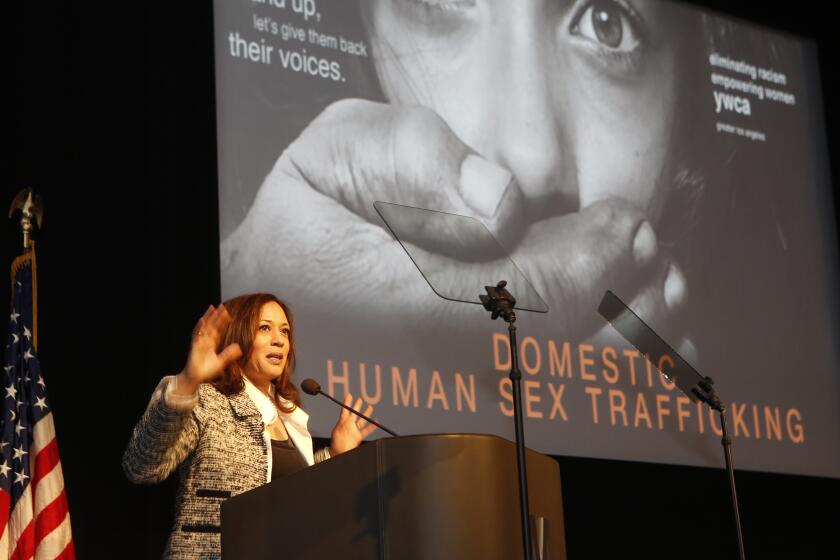Gov. Gavin Newsom is expanding the size and role of the California governor’s office

Reporting from Sacramento — Gov. Gavin Newsom announced plans to hire California’s first surgeon general hours after he took office last month. The next day he announced a new senior advisor for emergency management. Then on his third day, he created a “strike team” to reinvent the troubled Department of Motor Vehicles.
And on Day 4, Newsom unveiled a new state budget, requesting 41 additional staffers and a total of $24.6 million for the governor’s office — more spending than many of his predecessors.
California’s 40th governor is beginning his tenure with a flurry of ideas and enough cushion in the state budget to afford a large inner circle of advisors and aides to help carry out big promises, such as creating a single-payer healthcare system, universal preschool and addressing the state’s housing crisis.
“The truth about the governor’s office is that things move fast and you drink from a fire hose every day,” said Dana Williamson, a former top advisor to then-Gov. Jerry Brown. “He also has a big agenda.”
Brown had a lean crew of confidants. Former Gov. Arnold Schwarzenegger had a more expansive operation, with a $21.9-million budget and a staff of 202 employees at its peak during his final full year in office. Chief executives before him also oversaw large offices, but because some of their employees were paid from the budgets of different departments, it is unclear just how many staff members worked for them.
Facing a $27-billion budget deficit, Brown whittled the size of the governor’s office down to as few as 81 employees and a low of $12.7 million to cover salaries, benefits and administrative overhead.
He also closed the administration’s field offices around the state, eliminated the first lady’s office and forced appointees to take a 5% pay cut in keeping with campaign promises to limit government spending. Williamson said that Brown’s first stint in the governor’s office eased his return to the job more than three decades later, allowing him to operate with a small staff.
Newsom has taken a different approach.
Building a 132-person staff will allow Newsom to reopen five field offices focused on constituent affairs and hire representatives for each region of the state, said Nathan Click, a spokesman for the governor. The outposts will hold public office hours “to bring the governor’s office closer to the communities it serves,” Click said.
Newsom’s hiring spree will also bulk up his Cabinet, a team of senior advisors and high-ranking heads of state agencies. Click said that focus “affords this administration the capacity to make state government work better for the people it serves — from taking aggressive actions to combat the cost crisis families face to more quickly and effectively reacting in times of crisis and disaster.”
In another reversal of course from the Brown administration, Newsom is establishing the Office of the First Partner, his wife Jennifer Siebel Newsom’s preferred title, with seven new positions and a $791,000 budget.
The governor’s office has touted its work to hire a diverse staff — by geography, race and ethnicity, sexual orientation, gender identity, experience and disability status.
“It’s not a shock that a new activist governor would try to bulk up the staff as much as possible,” said Jack Pitney, a professor of government at Claremont McKenna College.
But Pitney also warned about the potential for “bureaucratic infarction.”
“That is, you have so many people sending so many memos to one another that nothing gets done,” he said.
Building a larger office means the 51-year-old governor will probably be more visible than his predecessor — a key component of remaining connected to the Californians who elected him last year. But Newsom’s penchant for launching so-called strike teams to tackle key issues and strategically announcing several hires at once is uncommon compared to past governors, said Susan Kennedy, who was Cabinet secretary to former Gov. Gray Davis and chief of staff to Schwarzenegger.
Last month, Newsom formed a panel to help his administration navigate the bankruptcy of Pacific Gas & Electric. He appointed his chief of staff, Ann O’Leary, to head the group with representatives from the California Independent System Operator, California Public Utilities Commission, California Department of Insurance and California Department of Finance.
He also formed a DMV strike team, led by California Government Operations Agency Secretary Marybel Batjer, to guide a reinvention of the troubled DMV and recommend new leadership. In December and again in January, Newsom rolled out several key positions at the same time, with titles such as “senior policy advisor for cradle to career” and “senior policy advisor for early childhood.”
Forming teams early on shows the governor is putting “boots on the ground” to move quickly and tackle important issues, said Kennedy, who commended Newsom’s hiring of top aides from previous administrations.
“He’s clearly using all the positions he has to make sure he has special teams who are able to bring the people into the process,” Kennedy said. “You exponentially increase your power when you have the ability to get the public, the constituency groups, behind you.”
Newsom has also said he might appoint “czars” to oversee policy on housing, mental health and homelessness, or some combination of the issues.
“I’ve talked a big game about czars, but I haven’t done a czar yet,” Newsom said at a recent news conference.
Though some suggest that selecting independent-minded leaders and new top advisors might allow Newsom to distance himself from any failed policies, others say the governor won’t be able to avoid blame or praise.
“The principal owns the problems and the principal owns the solutions,” said Eric Jaye, a former political advisor to Newsom. “If you succeed, you get the credit, and if you fail, you get the credit.”
Get the latest California politics news »
Follow @tarynluna on Twitter and sign up for our daily Essential Politics newsletter.
More to Read
Get the L.A. Times Politics newsletter
Deeply reported insights into legislation, politics and policy from Sacramento, Washington and beyond. In your inbox three times per week.
You may occasionally receive promotional content from the Los Angeles Times.











